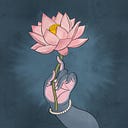Hindu Cosmology in Patañjali’s yōga sūtras
In the tritīya pāda of Patañjali’s yoga sūtras, called the Vibhūti pāda, the method of attainment of vibhūtis (or siddhis), i.e. mystic powers is stated to be through the practice of Saṁyama. Saṁyama is itself the combination of three different limbs of yogic sādhana — dhāraṇā or concentration or fixation of the mind, dhyāna, or contemplation of a single object or thought without distraction, and samādhi or meditative absorption, the last being the ultimate aim of yoga.
tad evārtha-mātra-nirbhāsam svarūpa-śūnyam iva samādhiḥ III.3
“Samādhi is achieved when, through dhyāna, the object alone is enlightened and becomes devoid of its own identity.”taj-jayāt prajñālokaḥ III.5
“Through achieving Saṁyama comes insight or lucidity of conciousness.”
Patañjali states that saṁyama directed towards various subjects can confer different yogic or mystical powers or vibhūtis. For instance, by performing saṁyama on the distinction between words, their meaning, and the image conjured in the mind (which are often confused for one another) the knowledge of the sounds produced by all creatures arises, that is, the yogi can perceive the meaning embedded in any śabda or sound even without being privy to that language. (III.17)
Another is the attainment of the knowledge of previous births, pūrva-jāti-jñānam, upon mental conjuring of the past’s impressions on the mind, or saṁyama over its karma and memories; and the power of invisibility, or the suspension of ocular perception of the bodily form, from saṁyama upon the external form of the body.
The knowledge of one’s own death:
Karma is can either be active or dormant, slowly winding with the wheels of time. By saṁyama on karma, or on its portents (corporeal,elemental or celestial), results the knowledge of one’s death. Yogīs adept in this practice can see the exact time and place of their own death, as if visible before their very eyes. According to Śankara, purpose of gaining the knowledge of one’s death is to fulfil one’s human obligations before then, and hasten their pursuit of mokṣa.
Of the many vibhūtis or mystic powers attainable through saṁyama, sūtras III.26–28 describe the attainment of the knowledge of the universe.
From saṁyama on the sun arises the knowledge of the different realms in the world. (III.26)
There are seven lōkās or realms of the universe in Hindu cosmology. From Avīcī to the Mount Meru with all its inhabitants is the earth, from Meru to Dhruva (the pole star) is the starry region occupied by the stars and planets, and five celestial regions beyond these. The first of the is the Mahendra, followed by the Prajāpatya or Maharlōka, the Janaloka, Tapoloka and the Satyaloka. Above the Avīcī are the six hellish regions, Mahākāla, Ambarīṣa, Raurava, Mahāraurava, Kāleya Sutra and Andhatāmisra — respectively placed in the realms of the Earth, Water, Fire, Air, Space, and Darkness.
Under these deep in the crevices of the universe are the seven netherworlds, Mahātala, Rasātala, Atala, Sutala, Vitala, Talātala, Pātāḷa.
In the earthly realm are seven islands, at the centre of which is the mountain made of solid gold, Meru.
यो वायं द्वीप: कुवलयकमलकोशाभ्यन्तरकोशो नियुतयोजन विशाल: समवर्तुलो यथा पुष्करपत्रम् ॥ Bhāgavata Purāṇa 5.16.5
The planetary system of Bhū-maṇḍala resembles a lotus flower, and its seven islands resemble the whorl of petals of that flower. The length and breadth of the island known as Jambūdvīpa, which is rounded like the lotus leaf, situated in the middle of the whorl, are one million yojanas each.
The sun revolves around Sumeru, causing day and night, and on the right of this mountain is the Jambū tree, which is why the earth is known as Jambūdvīpa. Jambūdvīpa consists of nine continents, each bounded by a great mountain, as Bhāratvarṣa by the Himālaya.
एवं जम्बूफलानामत्युच्चनिपातविशीर्णानामनस्थिप्रायाणामिभकायनिभानां रसेन जम्बू नाम नदी मेरुमन्दरशिखरादयुतयोजनादवनितले निपतन्ती दक्षिणेनात्मानं यावदिलावृतमुपस्यन्दयति ॥Bhāgavata Purāṇa 5.16.19
“The fruits of the jambū tree are the size of elephants, juicy and have very small seeds. They fall from a great height and break to pieces, the juice flowing from them becomes a river named Jambū-nadi. This river falls from a height of 10,000 yojanas, from the summit of Merumandāra to the southern side of Ilāvṛta, and floods the entire land of Ilāvṛta with juice.”
Patañjali states that this entire cosmography can be directly perceived by the yogī performing saṁyama on the sun, and in the next sūtra, states that saṁyama] on the moon, results in knowledge of the starry region (the positions of the stars and plants, and knowledge of the solar systems).
In the same vein, saṁyama on the Pole Star, Dhruva, results in knowledge of the motion of stars in the universe. In this way, mystical yogic powers, knowledge of the secrets of the universe, their influence on worldly creatures and more can be perceived by the yogi by focusing his austerities on various objects.
References:
- Yoga Darsana: Sutras of Patanjali with Bhasya of Vyasa by Ganganath Jha
- Edwin F. Bryant, The Yoga Sutras of Patañjali
______________________________________________________________
If you find value in my work, I hope you consider becoming a patron through Patreon. Hindu Aesthetic requires a lot of time and effort and your support would mean that I can continue bringing you the highest quality content. Link to my Patreon:
